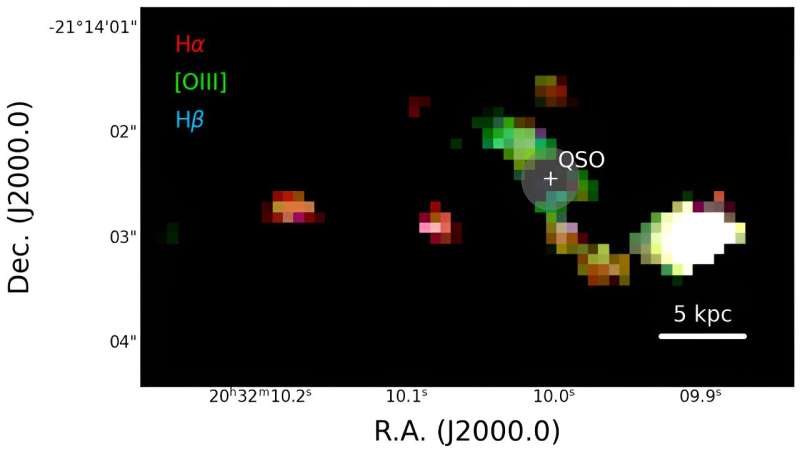
Map of the line emission from hydrogen (in red and blue) and oxygen (in green) in the PJ308-21 system, shown after masking the light from the central quasar (“QSO”). The different colors of the quasar’s host galaxy and companion galaxies in this map reveal the physical properties of the gas within it. Credit: Decarli/INAF/A&A 2024
An international research group led by the Italian National Institute for Astrophysics (INAF) and comprising 34 research institutes and universities worldwide used the Near-Infrared Spectrograph (NIRSpec) onboard the James Webb Space Telescope (JWST) to witness the dramatic interaction between a quasar in the PJ308–21 system and two massive satellite galaxies in the distant Universe.
The observations, made in September 2022, revealed unprecedented and awe-inspiring details, providing new insights into the growth of galaxies in the early Universe. The results, presented on 5 July at the European Astronomical Society meeting (EAS 2024) in Padua, Italy, will soon be published in Astronomy & Astrophysics.
Observations of this quasar (which the same authors already described in another study published last May) are among the first studied with NIRSpec, when the Universe was less than a billion years old (redshift z = 6.2342). These observations have yielded data of sensational quality: the instrument “captured” the quasar’s spectrum with an uncertainty of less than 1% per pixel.
The host galaxy of PJ308–21 exhibits high metal abundance and photoionization conditions characteristic of an active galactic nucleus (AGN), while one of the satellite galaxies exhibits low metal abundance (referring to the abundance of chemical elements heavier than hydrogen and helium) and photoionization caused by star formation; a higher metal abundance characterizes the second satellite galaxy, which is partially ionized by the quasar.
The discovery allowed astronomers to determine the mass of the supermassive black hole at the center of the system (about 2 billion solar masses). It also confirmed that both the quasar and the surrounding galaxies have evolved greatly in mass and metal enrichment, and are constantly growing.
This has major implications for our understanding of cosmic history and the chemical evolution of galaxies, underscoring the transformative impact of this research.
Roberto Decarli, a researcher at INAF in Bologna and first author of the paper, explains: “Our study shows that both the black holes at the centre of high-redshift quasars and the galaxies in which they reside undergo extremely efficient and turbulent growth already in the first billion years of cosmic history, helped by the rich galactic environment in which these sources are born.”
The data were acquired in September 2022 as part of Program 1554, one of nine Italian-led projects of JWST’s first observing cycle. Decarli leads this program to observe the merger between the galaxy hosting the quasar (PJ308-21) and two of its satellite galaxies.
The observations were performed in integral field spectroscopy mode: for each image pixel, the spectrum of the entire optical band (in the source rest frame) can be observed, shifted to the infrared by the expansion of the Universe. This allows to study different gas tracers (emission lines) using a 3D approach.
This technique allowed the INAF-led team to detect spatially extended emissions of several elements. These were used to study the properties of the ionized interstellar medium, including the source and hardness of the photoionizing radiation field, the metal content, the dust obscuration, the electron density and temperature, and the star formation rate.
In addition, the researchers detected limited starlight emission associated with companion sources.
Federica Loiacono, astrophysicist, researcher and postdoc at INAF, says: “NIRSpec allows us to study for the first time in the PJ308-21 system the optical band, which is rich in valuable diagnostic data on the properties of the gas near the black hole in the galaxy hosting the quasar and in the surrounding galaxies.
“For example, we can see the emission from hydrogen atoms and compare it to the chemical elements produced by the stars. This allows us to determine how rich the gas in galaxies is in metals.
“The experience with the reduction and calibration of these data, some of which were collected for the first time with NIRSpec in integral field spectroscopy mode, has provided a strategic advantage for the Italian community in managing similar data from other programs.” Loiacono is the Italian contact person for NIRSpec data reduction at the INAF JWST Support Center.
She adds: “Thanks to the sensitivity of the James Webb Space Telescope in the near and mid-infrared, it was possible to study the spectrum of the quasar and its companion galaxies with unprecedented precision in the distant Universe. Only the excellent ‘seeing’ offered by JWST, with its unparalleled capabilities, can guarantee these observations.”
The work was a real “emotional rollercoaster,” Decarli continues, “with the need to develop innovative solutions to overcome the initial difficulties in reducing data.”
This transformative impact of the James Webb Space Telescope’s onboard instruments underscores its critical role in advancing astrophysical research.
“Until a few years ago, data on metal enrichment (essential for understanding the chemical evolution of galaxies) were almost beyond our reach, especially at these distances. Now we can map them in detail with just a few hours of observation, even in galaxies observed when the Universe was still in its infancy,” concludes Decarli.
More information:
Roberto Decarli et al, A quasar-galaxy merger at z~6.2: Rapid growth of the host via the accretion of two massive satellite galaxies, Astronomy & Astrophysics (2024). Developed by: On arXiv: DOI: 10.48550/arxiv.2406.06697
Provided by the National Institute of Astronomy
Quote: Webb Captures Stunning Quasar-Galaxy Merger in Distant Universe (2024, July 5) Retrieved July 6, 2024, from https://phys.org/news/2024-07-webb-captures-staggering-quasar-galaxy.html
This document is subject to copyright. Except for fair dealing for private study or research, no part may be reproduced without written permission. The contents are supplied for information purposes only.
